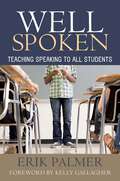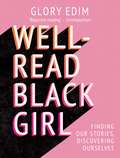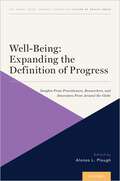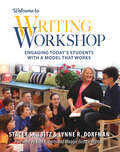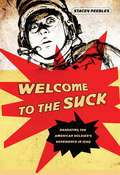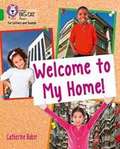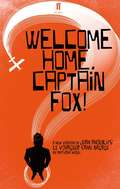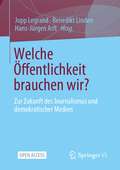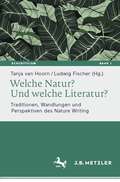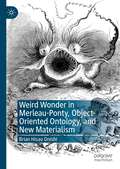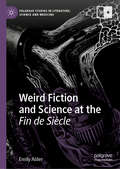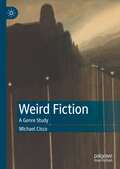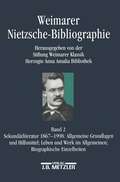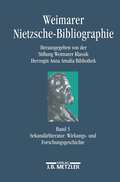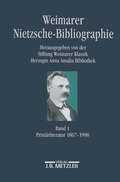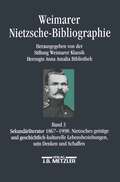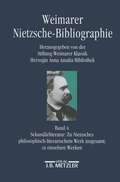- Table View
- List View
Wellington Square, Level 1, Set B: A fish for Jamila
by Keith Gaines Tessa KrailingThe duck likes Jamila's cake and wants another piece, but Jamila has no more. What does the duck do then? Wellington Square is designed to meet the needs of children aged 7-13+ who are having difficulty in learning to read. It provides straightforward progression through all 5 levels of the scheme, from wordless picture books to storybooks with full-text. Wellington Square widens your pupils' reading experience through imaginative and stimulating support material.
Wellington Square, Level 1, Set B: Apples for Bruce (2001 edition)
by Gaines, Keith|Krailing, Tessa"Jamila was putting apples into a pile. Mr Keeping bought a bag of apples. 'They are good apples,' said Jamila. 'Are they for Bruce?'
Wellington Square, Level 1, Set B: In the Bag!
by Gaines, Keith|Krailing, TessaMax runs off with Mr Keeping's bag and 3ruce gets out. Where does he end up? Wellington Square is designed to meet the needs of children aged 7-13+ who are having difficulty in learning to read. It provides straightforward progression through all 5 levels of the scheme, from wordless picture books to storybooks with full-text. Wellington Square widens your pupils' reading experience through imaginative and stimulating support material.
Wellington Square, Level 1, Set B: The Duke of Wellington
by Gaines, Keith|Krailing, TessaJamila is surprised when the Duke of Wellington comes in the shop. He buys some crisps and she decides to follow him ... Wellington Square is designed to meet the needs of children aged 7-13+ who are having difficulty in learning to read. It provides straightforward progression through all 5 levels of the scheme, from wordless picture books to storybooks with full-text. Wellington Square widens your pupils' reading experience through imaginative and stimulating support material.
Wellington Square, Level 1, Set B: Apples for Bruce (2001 edition) (PDF)
by Gaines Keith Krailing Tessa"Jamila was putting apples into a pile. Mr Keeping bought a bag of apples. 'They are good apples,' said Jamila. 'Are they for Bruce?'
Well Spoken: Teaching Speaking to All Students
by Erik PalmerAll teachers at all grade levels in all subjects have speaking assignments for students, but many teachers believe they don't know how to teach speaking, and many even fear public speaking themselves. In his new book, Well Spoken, veteran teacher and education consultant Erik Palmer shares the art of teaching speaking in any classroom. Teachers will find thoughtful and engaging strategies for integrating speaking skills throughout the curriculum. Palmer stresses the essential elements of all effective oral communication, including:, Building a Speech: Audience, Content, Organization, Visual Aids, and Appearance, Performing a Speech: Poise, Voice, Life, Eye Contact, Gestures, and Speed, Evaluating a Speech: Creating Effective Rubrics,' Guiding Students to Excellence Well Spoken contains a framework for understanding the skills involved in all effective oral communication, offers practical steps and lesson ideas that any teacher needs to successfully teach speaking in a variety of situationsfrom classroom discussions to' formal presentationsand includes a set of tools for studentsfrom how to grab the audience's attention to how to use emphatic hand gestures and adjust speed for effect. Discover why, year after year, students returned to Palmer's classroom to thank him for teaching them how to be well spoken. You may find, after reading this book, that you have become a better speaker, too.
Well Spoken: Teaching Speaking to All Students
by Erik PalmerAll teachers at all grade levels in all subjects have speaking assignments for students, but many teachers believe they don't know how to teach speaking, and many even fear public speaking themselves. In his new book, Well Spoken, veteran teacher and education consultant Erik Palmer shares the art of teaching speaking in any classroom. Teachers will find thoughtful and engaging strategies for integrating speaking skills throughout the curriculum. Palmer stresses the essential elements of all effective oral communication, including:, Building a Speech: Audience, Content, Organization, Visual Aids, and Appearance, Performing a Speech: Poise, Voice, Life, Eye Contact, Gestures, and Speed, Evaluating a Speech: Creating Effective Rubrics,' Guiding Students to Excellence Well Spoken contains a framework for understanding the skills involved in all effective oral communication, offers practical steps and lesson ideas that any teacher needs to successfully teach speaking in a variety of situationsfrom classroom discussions to' formal presentationsand includes a set of tools for studentsfrom how to grab the audience's attention to how to use emphatic hand gestures and adjust speed for effect. Discover why, year after year, students returned to Palmer's classroom to thank him for teaching them how to be well spoken. You may find, after reading this book, that you have become a better speaker, too.
Well-Read Black Girl: Finding Our Stories, Discovering Ourselves
by Glory Edim'Required reading.' - Cosmopolitan'This should be read as a sacred text. Here, you will bear witness to a perpetual salvation song.' - Jason ReynoldsRemember that moment when you first encountered a character who seemed to be written just for you? That feeling of belonging remains with readers the rest of their lives - but not everyone regularly sees themselves reflected on the pages of a book.In this timely anthology, Glory Edim, founder of the online community, Well-Read Black Girl, brings together original essays by some of America's best black women writers to shine a light on how important it is that we all - regardless of gender, race, religion, or ability - have the opportunity to find ourselves in literature. Whether it's learning about the complexities of femalehood from Zora Neale Hurston and Toni Morrison, finding a new type of love in The Color Purple, or using mythology to craft an alternative black future, each essay reminds us why we turn to books in times of both struggle and relaxation. As she has done with her book club-turned-online community, Edim has created a space where black women's writing, knowledge and life experiences are lifted up, to be shared with all readers who value the power of a story to help us understand the world, and ourselves.Contributors include: Jesmyn Ward, Lynn Nottage, Jacqueline Woodson, Gabourey Sidibe, Morgan Jerkins, Tayari Jones, Rebecca Walker, and Barbara Smith.'Essential reading for the twenty-first-century reader. This book is smart, powerful, and complete.' - Min Jin Lee, author of Pachinko
Well-Being: Insights From Practitioners, Researchers, and Innovators From Around the Globe (Culture of Health)
by Alonzo L. PloughCities and countries around the world, from New Zealand to Singapore to Iceland, are starting to take a well-being approach by reorienting policies, budgets and other actions to advance human and planetary well-being. Well-being metrics--holistic measurements of an individual's or population's capacity to thrive, including the condition of their community, society, and environment--provide a nuanced and predictive view that transcends purely economic measures; they illuminate conditions of inequity and despair that other tools ignore, and expand the notion of health beyond simply the absence of disease. Well-Being: Expanding the Definition of Progress summarizes the experiences and insights of practitioners, researchers and innovators from around the world, gathered together by the Robert Wood Johnson Foundation to explore how a well-being approach might further spread in the United States. Centered in the commitment to balance economic growth--the traditional dashboard of progress--with well-being, this book is a combination of scientific papers, case studies from the field, and excerpts from a lively, multidisciplinary discussion which intentionally connects issues of measurement to the imperative for action. Rich with insights on policy and practice, narratives and culture, equity and shifts in power, alignment with other movements, and cross-sector collaboration, it is intended to inspire governmental leaders, policymakers, economists, measurement scientists, reporters, and others who crave a more integrated and balanced pursuit of progress.
Well-Being: Insights From Practitioners, Researchers, and Innovators From Around the Globe (Culture of Health)
Cities and countries around the world, from New Zealand to Singapore to Iceland, are starting to take a well-being approach by reorienting policies, budgets and other actions to advance human and planetary well-being. Well-being metrics--holistic measurements of an individual's or population's capacity to thrive, including the condition of their community, society, and environment--provide a nuanced and predictive view that transcends purely economic measures; they illuminate conditions of inequity and despair that other tools ignore, and expand the notion of health beyond simply the absence of disease. Well-Being: Expanding the Definition of Progress summarizes the experiences and insights of practitioners, researchers and innovators from around the world, gathered together by the Robert Wood Johnson Foundation to explore how a well-being approach might further spread in the United States. Centered in the commitment to balance economic growth--the traditional dashboard of progress--with well-being, this book is a combination of scientific papers, case studies from the field, and excerpts from a lively, multidisciplinary discussion which intentionally connects issues of measurement to the imperative for action. Rich with insights on policy and practice, narratives and culture, equity and shifts in power, alignment with other movements, and cross-sector collaboration, it is intended to inspire governmental leaders, policymakers, economists, measurement scientists, reporters, and others who crave a more integrated and balanced pursuit of progress.
Welcome to Writing Workshop: Engaging Today's Students with a Model That Works
by Lynne Dorfman Stacey ShubitzStacey Shubitz and Lynne Dorfman welcome you to experience the writing workshop for the first time or in a new light with Welcome to Writing Workshop: Engaging Today's Students with a Model That Works . Through strategic routines, tips, resources, and short focused video clips, teachers can create the sights and sounds of a thriving writing workshop where:• Both students and teachers are working authors• Students spend most of their time writing—not just learning about it• Student choice is encouraged to help create engaged writers, not compliant ones• Students are part of the formative assessment process• Students will look forward to writing time—not dread it.From explanations of writing process and writing traits to small-group strategy lessons and mini-lessons, this book will provide the know-how to feel confident and comfortable in the teaching of writers.
Welcome to Writing Workshop: Engaging Today's Students with a Model That Works
by Lynne Dorfman Stacey ShubitzStacey Shubitz and Lynne Dorfman welcome you to experience the writing workshop for the first time or in a new light with Welcome to Writing Workshop: Engaging Today's Students with a Model That Works . Through strategic routines, tips, resources, and short focused video clips, teachers can create the sights and sounds of a thriving writing workshop where:• Both students and teachers are working authors• Students spend most of their time writing—not just learning about it• Student choice is encouraged to help create engaged writers, not compliant ones• Students are part of the formative assessment process• Students will look forward to writing time—not dread it.From explanations of writing process and writing traits to small-group strategy lessons and mini-lessons, this book will provide the know-how to feel confident and comfortable in the teaching of writers.
Welcome to the Suck: Narrating the American Soldier's Experience in Iraq
by Stacey PeeblesOur collective memories of World War II and Vietnam have been shaped as much by memoirs, novels, and films as they have been by history books. In Welcome to the Suck, Stacey Peebles examines the growing body of contemporary war stories in prose, poetry, and film that speak to the American soldier’s experience in the Persian Gulf War and the Iraq War. Stories about war always encompass ideas about initiation, masculinity, cross-cultural encounters, and trauma. Peebles shows us how these timeless themes find new expression among a generation of soldiers who have grown up in a time when it has been more acceptable than ever before to challenge cultural and societal norms, and who now have unprecedented and immediate access to the world away from the battlefield through new media and technology.Two Gulf War memoirs by Anthony Swofford (Jarhead) and Joel Turnipseed (Baghdad Express) provide a portrait of soldiers living and fighting on the cusp of the major political and technological changes that would begin in earnest just a few years later. The Iraq War, a much longer conflict, has given rise to more and various representations. Peebles covers a blog by Colby Buzzell ("My War"), memoirs by Nathaniel Fick (One Bullet Away) and Kayla Williams (Love My Rifle More Than You); a collection of stories by John Crawford (The Last True Story I’ll Ever Tell); poetry by Brian Turner (Here, Bullet); the documentary Alive Day Memories; and the feature films In the Valley of Elah and the winner of the 2010 Oscar for Best Picture, The Hurt Locker, both written by the war correspondent Mark Boal. Books and other media emerging from the conflicts in the Gulf have yet to receive the kind of serious attention that Vietnam War texts received during the 1980s and 1990s. With its thoughtful and timely analysis, Welcome to the Suck will provoke much discussion among those who wish to understand today’s war literature and films and their place in the tradition of war representation more generally.
Welcome To My Home: Band 5 Green (PDF) (Collins Big Cat Phonics For Letters And Sounds Ser.)
by Catherine BakerCollins Big Cat Phonics for Letters and Sounds features exciting fiction and non-fiction decodable readers to enthuse and inspire children. They are fully aligned to Letters and Sounds Phases 1-6 and contain notes in the back. The Handbooks provide support in demonstration and modelling, monitoring comprehension and expanding vocabulary. Join Ana, Eric and Jodie as they give you a tour of their home lives in Brazil, Kenya and Hong Kong in this non-fiction book. Green (Band 5) books offer early readers patterned language and varied characters. The focus sounds in this book are: /igh/ i, i-e /ai/ ay, a-e /oa/ o, ow, o-e /oo/ u, ew, ou /ee/ ie, ea /ow/ ou /ar/ a /or/ al /air/ ere /u/ o-e Pages 22 and 23 allow children to re-visit the content of the book, supporting comprehension skills, vocabulary development and recall. Reading notes within the book provide practical support for reading Big Cat Phonics for Letters and Sounds with children, including a list of all the sounds and words that the book will cover.
Welcome Home, Captain Fox! (Faber Drama Ser.)
by Anthony WeighIt's the legendary hot summer of 1959 and while the Cold War rages and America tunes into I Love Lucy, Captain Jack Fox - believed missing in action in the fields of France fifteen years before - is about to be reunited with his family in the Hamptons.But is this really Jack Fox? And if it isn't, who is this man? And why are there twenty-two other families so intent on claiming him as their own?A sparkling comedy of identity, lost and found, based on Jean Anouilh's hit 1937 play, Le Voyageur sans bagage, Anthony Weigh's Welcome Home, Captain Fox! premiered at the Donmar Warehouse, London, in February 2016.
Welche Öffentlichkeit brauchen wir?: Zur Zukunft des Journalismus und demokratischer Medien
by Jupp Legrand Benedikt Linden Hans-Jürgen ArltIn diesem Open Access-Sammelband reflektieren namhafte Autor:innen aus Wissenschaft und Praxis Blockaden und Chancen eines zukünftigen, besseren Mediensystems. Ausgehend von der These, dass Journalismus, Medien und Öffentlichkeit gegenwärtig einen tiefgreifenden strukturellen Wandel durchlaufen, bündelt der Band Kritiken am Status Quo, alternative Wege der Transformation und Vorschläge für Verbesserungen unter dem Stichwort Demokratisierung. Finanzierung, Produktion, Distribution und Rezeption sowie Themensetzung und Formate von Öffentlichkeit werden vor dem Hintergrund langfristiger technologischer, ökonomischer und sozialer Prozesse kritisch analysiert und auf ihr demokratisches Potential abgeklopft.Das Buch richtet sich gleichermaßen an Medien- und Kommunikationswissenschaftler:innen wie an Akteure aus der medienpolitischen und journalistischen Praxis, die im und über das Alltagsgeschäft hinaus den Medienwandel mitgestalten und sich vom Ziel einer demokratischen Öffentlichkeit leiten lassen.
Welche Natur? Und welche Literatur?: Traditionen, Wandlungen und Perspektiven des Nature Writing (Ecocriticism. Literatur-, kultur- und medienwissenschaftliche Perspektiven #1)
by Tanja Van Hoorn Ludwig FischerMit diesem Band gewinnt die deutschsprachige Forschung transdisziplinär Anschluss an die internationalen Nature Writing-Diskussionen. Der Sammelband sondiert das Feld des Nature Writing hinsichtlich der Frage, welche Natur dabei in den unterschiedlichen historisch-kulturellen Konstellationen in jeweils welcher spezifischen literarischen Textur zur Darstellung kommt. Programmatisch-konzeptionell stehen damit nicht zuletzt die (möglicherweise verdeckt normativen) Naturvorstellungen des klassischen und rezenten Nature Writing zur Diskussion. Dies wird in exemplarischen Lektüren untersucht, etwa, indem die Kategorien einer ›unberührten‹ Natur bzw. des ›Wilden‹ – auch im Kontext des sogenannten Rewilding – problematisiert oder aber die ästhetisch geformte Darstellung zivilisatorisch veränderter, sei es anthropogen zerstörter, sei es gärtnerischer gestalteter Natur analysiert wird. Präsentiert werden Beiträge aus amerikanistischer, germanistischer, philosophischer und biologiegeschichtlicher Perspektive zu prominenten Vertreter*innen des englischsprachigen Nature Writing (Henry David Thoreau, Val Plumwood u.a.) ebenso wie zu indigenem Natur-Wissen (Robin Wall Kimmerer) und zu Werken deutschsprachiger naturaffiner Autor*innen der Tradition (Adalbert von Chamisso) und Gegenwart (z.B. Ulrike Draesner, Esther Kinsky und W.G. Sebald). Die Untersuchungen ästhetischer Natur-Darstellungsverfahren erfolgen in close readings sowie im Horizont von politischer Ökologie, New Materialism, Ecocriticism, den seit geraumer Zeit gerade in England geführten Diskussionen zu Möglichkeiten und Grenzen eines New Nature Writing und den jüngsten Bestrebungen, die verschüttete Linie eines deutschsprachigen Nature Writing zu rekonstruieren.
Weird Wonder in Merleau-Ponty, Object-Oriented Ontology, and New Materialism
by Brian Hisao OnishiThis book connects recent developments in speculative realism, new materialism, and eco-phenomenology to articulate an approach to wonder that escapes the connected traps of anthropocentrism and correlationism. Brian Onishi argues that wonder has explanatory power for the constitution of the world and the organization of meaning. To do this, he appeals to both fiction (speculative and Weird fiction in particular) and quantum physics. More specifically, he argues that the focus of Weird fiction on impossible experiences and a feeling of something just beyond the limits of one’s grasp dramatizes the speculative reach beyond the limits of our understanding. But more than a tool for knowledge acquisition, wonder is an organizing property of objects. Like the collapse of superposition in quantum physics, reality is constituted when objects reveal themselves to other objects and thereby organize themselves into complex objects. Since no relation is exhaustive, the capacity to wonder remains at a material level, and the possibility of reorganization is ever present. Ultimately, Onishi argues for a speculative eco-phenomenology with wonder as an engine for a Weird environmental ethics.
Weird Fiction and Science at the Fin de Siècle (Palgrave Studies in Literature, Science and Medicine)
by Emily AlderThis book explores how nineteenth-century science stimulated the emergence of weird tales at the fin de siècle, and examines weird fiction by British writers who preceded and influenced H. P. Lovecraft, the most famous author of weird fiction. From laboratory experiments, thermodynamics, and Darwinian evolutionary theory to psychology, Theosophy, and the ‘new’ physics of atoms and forces, science illuminated supernatural realms with rational theories and practices. Changing scientific philosophies and questioning of traditional positivism produced new ways of knowing the world—fertile borderlands for fictional as well as real-world scientists to explore. Reading Robert Louis Stevenson’s Strange Case of Dr Jekyll and Mr Hyde (1886) as an inaugural weird tale, the author goes on to analyse stories by Arthur Machen, Edith Nesbit, H. G. Wells, William Hope Hodgson, E. and H. Heron, and Algernon Blackwood to show how this radical fantasy mode can be scientific, and how sciences themselves were often already weird.
Weird Fiction: A Genre Study
by Michael CiscoWeird Fiction: A Genre Study presents a comprehensive, contemporary analysis of the genre of weird fiction by identifying the concepts that influence and produce it. Focusing on the sources of narrative content—how the content is produced and what makes something weird—Michael Cisco engages with theories from Deleuze and Guattari to explain how genres work and to understand the relationship between identity and the ordinary. Cisco also uses these theories to examine the supernatural not merely as a horde of tropes, but as a recognition of the infinity of experience in defiance of limiting norms. The book also traces the sociopolitical implications of weird fiction, studying the differentiation of major and minor literatures. Through an articulated theoretical model and close textual analysis, readers will learn not only what weird fiction is, but how and why it is produced.
Weimarer Nietzsche-Bibliographie in 5 Bänden: Band 2: Sekundärliteratur 1867-1998: Allgemeine Grundlagen und Hilfsmittel; Leben und Werke im Allgemeinen; Biographische Einzelheiten
Die Weimarer Nietzsche-Bibliographie erfasst die zwischen 1867 und 1998 erschienene Primär- und Sekundärliteratur aller Sprachen und Länder. Ziel ist es, ein zuverlässiges bibliographisches Grundlagenwerk zu Leben, Werk und Wirkung Nietzsches für die internationale Einzelforschung und darüber hinaus für die Geisteswissenschaften insgesamt zu schaffen. Angestrebt wird ein hoher Grad an Vollständigkeit. Bei der Verzeichnung der Sekundärliteratur wird neben der eigentlichen Forschungsliteratur besonderes Augenmerk auf die Literatur zur Wirkungsgeschichte gelegt. Die Titelbeschreibung erfolgt weitgehend aufgrund der vorliegenden Originalquelle. An der Herzogin Anna Amalia Bibliothek ist mit der Privatbibliothek Friedrich Nietzsches und mit der Bibliothek des Nietzsche-Archivs, das bis 1945 seine Wirkungsstätte in Weimar hatte, ein Grundbestand der Nietzsche-Literatur vorhanden, der seit 1990 systematisch ausgebaut wird. Auf diesem Bestand konnte das Projekt einer umfassenden retrospektiven Personalbibliographie zu Friedrich Nietzsche aufbauen. Die Bibliographie erschließt die Literatur systematisch über Annotationen sowie über Register (Personen-, Sach- und Werkregister). Das Werk erscheint in fünf Bänden. Band 1 liegt bereits vor. Die übrigen vier Bände mit der Forschungsliteratur und der Literatur zur Wirkungsgeschichte folgen im April 2002. Insgesamt werden über 20.000 Dokumente verzeichnet. Die Weimarer Nietzsche-Bibliographie bildet die Plattform für jede Beschäftigung mit der internationalen Wirkung Nietzsches.
Weimarer Nietzsche-Bibliographie in 5 Bänden: Band 5: Sekundärliteratur: Wirkungs- und Forschungsgeschichte
Die Weimarer Nietzsche-Bibliographie erfasst die zwischen 1867 und 1998 erschienene Primär- und Sekundärliteratur aller Sprachen und Länder. Ziel ist es, ein zuverlässiges bibliographisches Grundlagenwerk zu Leben, Werk und Wirkung Nietzsches für die internationale Einzelforschung und darüber hinaus für die Geisteswissenschaften insgesamt zu schaffen. Angestrebt wird ein hoher Grad an Vollständigkeit. Bei der Verzeichnung der Sekundärliteratur wird neben der eigentlichen Forschungsliteratur besonderes Augenmerk auf die Literatur zur Wirkungsgeschichte gelegt. Die Titelbeschreibung erfolgt weitgehend aufgrund der vorliegenden Originalquelle. An der Herzogin Anna Amalia Bibliothek ist mit der Privatbibliothek Friedrich Nietzsches und mit der Bibliothek des Nietzsche-Archivs, das bis 1945 seine Wirkungsstätte in Weimar hatte, ein Grundbestand der Nietzsche-Literatur vorhanden, der seit 1990 systematisch ausgebaut wird. Auf diesem Bestand konnte das Projekt einer umfassenden retrospektiven Personalbibliographie zu Friedrich Nietzsche aufbauen. Die Bibliographie erschließt die Literatur systematisch über Annotationen sowie über Register (Personen-, Sach- und Werkregister). Das Werk erscheint in fünf Bänden. Band 1 liegt bereits vor. Die übrigen vier Bände mit der Forschungsliteratur und der Literatur zur Wirkungsgeschichte folgen im April 2002. Insgesamt werden über 20.000 Dokumente verzeichnet. Die Weimarer Nietzsche-Bibliographie bildet die Plattform für jede Beschäftigung mit der internationalen Wirkung Nietzsches.
Weimarer Nietzsche-Bibliographie in 5 Bänden: Band 1: Primärliteratur 1867-1998
Die Weimarer Nietzsche-Bibliographie erfasst die zwischen 1867 und 1998 erschienene Primär- und Sekundärliteratur aller Sprachen und Länder. Ziel ist es, ein zuverlässiges bibliographisches Grundlagenwerk zu Leben, Werk und Wirkung Nietzsches für die internationale Einzelforschung und darüber hinaus für die Geisteswissenschaften insgesamt zu schaffen. Angestrebt wird ein hoher Grad an Vollständigkeit. Bei der Verzeichnung der Sekundärliteratur wird neben der eigentlichen Forschungsliteratur besonderes Augenmerk auf die Literatur zur Wirkungsgeschichte gelegt. Die Titelbeschreibung erfolgt weitgehend aufgrund der vorliegenden Originalquelle. An der Herzogin Anna Amalia Bibliothek ist mit der Privatbibliothek Friedrich Nietzsches und mit der Bibliothek des Nietzsche-Archivs, das bis 1945 seine Wirkungsstätte in Weimar hatte, ein Grundbestand der Nietzsche-Literatur vorhanden, der seit 1990 systematisch ausgebaut wird. Auf diesem Bestand konnte das Projekt einer umfassenden retrospektiven Personalbibliographie zu Friedrich Nietzsche aufbauen. Die Bibliographie erschließt die Literatur systematisch über Annotationen sowie über Register (Personen-, Sach- und Werkregister). Das Werk erscheint in fünf Bänden. Band 1 liegt bereits vor. Die übrigen vier Bände mit der Forschungsliteratur und der Literatur zur Wirkungsgeschichte folgen im April 2002. Insgesamt werden über 20.000 Dokumente verzeichnet. Die Weimarer Nietzsche-Bibliographie bildet die Plattform für jede Beschäftigung mit der internationalen Wirkung Nietzsches.
Weimarer Nietzsche-Bibliographie in 5 Bänden: Band 3: Sekundärliteratur 1867-1998: Nietzsches geistige und geschichtskulturelle Lebensbeziehung, sein Denken und Schaffen
Die Weimarer Nietzsche-Bibliographie erfasst die zwischen 1867 und 1998 erschienene Primär- und Sekundärliteratur aller Sprachen und Länder. Ziel ist es, ein zuverlässiges bibliographisches Grundlagenwerk zu Leben, Werk und Wirkung Nietzsches für die internationale Einzelforschung und darüber hinaus für die Geisteswissenschaften insgesamt zu schaffen. Angestrebt wird ein hoher Grad an Vollständigkeit. Bei der Verzeichnung der Sekundärliteratur wird neben der eigentlichen Forschungsliteratur besonderes Augenmerk auf die Literatur zur Wirkungsgeschichte gelegt. Die Titelbeschreibung erfolgt weitgehend aufgrund der vorliegenden Originalquelle. An der Herzogin Anna Amalia Bibliothek ist mit der Privatbibliothek Friedrich Nietzsches und mit der Bibliothek des Nietzsche-Archivs, das bis 1945 seine Wirkungsstätte in Weimar hatte, ein Grundbestand der Nietzsche-Literatur vorhanden, der seit 1990 systematisch ausgebaut wird. Auf diesem Bestand konnte das Projekt einer umfassenden retrospektiven Personalbibliographie zu Friedrich Nietzsche aufbauen. Die Bibliographie erschließt die Literatur systematisch über Annotationen sowie über Register (Personen-, Sach- und Werkregister). Das Werk erscheint in fünf Bänden. Band 1 liegt bereits vor. Die übrigen vier Bände mit der Forschungsliteratur und der Literatur zur Wirkungsgeschichte folgen im April 2002. Insgesamt werden über 20.000 Dokumente verzeichnet. Die Weimarer Nietzsche-Bibliographie bildet die Plattform für jede Beschäftigung mit der internationalen Wirkung Nietzsches.
Weimarer Nietzsche-Bibliographie in 5 Bänden: Band 4: Sekundärliteratur: Zu Nietzsches philosophisch-literarischem Werk insgesamt; zu einzelnen Werken
Die Weimarer Nietzsche-Bibliographie erfasst die zwischen 1867 und 1998 erschienene Primär- und Sekundärliteratur aller Sprachen und Länder. Ziel ist es, ein zuverlässiges bibliographisches Grundlagenwerk zu Leben, Werk und Wirkung Nietzsches für die internationale Einzelforschung und darüber hinaus für die Geisteswissenschaften insgesamt zu schaffen. Angestrebt wird ein hoher Grad an Vollständigkeit. Bei der Verzeichnung der Sekundärliteratur wird neben der eigentlichen Forschungsliteratur besonderes Augenmerk auf die Literatur zur Wirkungsgeschichte gelegt. Die Titelbeschreibung erfolgt weitgehend aufgrund der vorliegenden Originalquelle. An der Herzogin Anna Amalia Bibliothek ist mit der Privatbibliothek Friedrich Nietzsches und mit der Bibliothek des Nietzsche-Archivs, das bis 1945 seine Wirkungsstätte in Weimar hatte, ein Grundbestand der Nietzsche-Literatur vorhanden, der seit 1990 systematisch ausgebaut wird. Auf diesem Bestand konnte das Projekt einer umfassenden retrospektiven Personalbibliographie zu Friedrich Nietzsche aufbauen. Die Bibliographie erschließt die Literatur systematisch über Annotationen sowie über Register (Personen-, Sach- und Werkregister). Das Werk erscheint in fünf Bänden. Band 1 liegt bereits vor. Die übrigen vier Bände mit der Forschungsliteratur und der Literatur zur Wirkungsgeschichte folgen im April 2002. Insgesamt werden über 20.000 Dokumente verzeichnet. Die Weimarer Nietzsche-Bibliographie bildet die Plattform für jede Beschäftigung mit der internationalen Wirkung Nietzsches.

